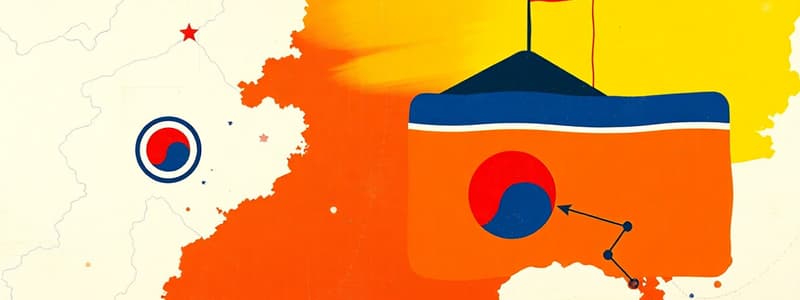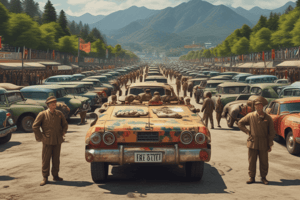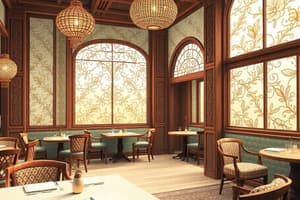Podcast
Questions and Answers
What is the primary characteristic of North Korea's economy?
What is the primary characteristic of North Korea's economy?
- Market-driven economy
- Mixed economy
- Command economy (correct)
- Free market economy
Which ideology is the command economy of North Korea rooted in?
Which ideology is the command economy of North Korea rooted in?
- Juche ideology (correct)
- Communist ideology
- Capitalist ideology
- Socialist ideology
What has been a significant result of the absence of incentives for productivity in North Korea?
What has been a significant result of the absence of incentives for productivity in North Korea?
- Increased foreign investment
- Technological advancement
- Economic prosperity
- Recurring famines (correct)
How does South Korea's economic growth compare to North Korea's?
How does South Korea's economic growth compare to North Korea's?
What role does political institution play in shaping economic outcomes?
What role does political institution play in shaping economic outcomes?
Which sector in South Korea demonstrates the benefits of government support?
Which sector in South Korea demonstrates the benefits of government support?
What has contributed to South Korea's improved quality of life?
What has contributed to South Korea's improved quality of life?
What defines the Arduous March in North Korea?
What defines the Arduous March in North Korea?
What was the primary focus of economic policy under General Park Chung-Hee's regime?
What was the primary focus of economic policy under General Park Chung-Hee's regime?
Which policy was aimed at ensuring regime survival and internal control in South Korea?
Which policy was aimed at ensuring regime survival and internal control in South Korea?
During which phase did Syngman Rhee serve as the first president of South Korea?
During which phase did Syngman Rhee serve as the first president of South Korea?
What significant change occurred in South Korea during the late 1980s and early 1990s?
What significant change occurred in South Korea during the late 1980s and early 1990s?
Which of the following best describes the economic system adopted by South Korea?
Which of the following best describes the economic system adopted by South Korea?
What was a common consequence of the authoritarian regimes in South Korea regarding political dissent?
What was a common consequence of the authoritarian regimes in South Korea regarding political dissent?
What was a key feature of the economic policies in the Miracle of the Han River?
What was a key feature of the economic policies in the Miracle of the Han River?
What ideology did Syngman Rhee strongly oppose during his presidency?
What ideology did Syngman Rhee strongly oppose during his presidency?
What was the primary ideological influence over North Korea after its division in 1945?
What was the primary ideological influence over North Korea after its division in 1945?
What role did Syngman Rhee play in South Korea's political landscape?
What role did Syngman Rhee play in South Korea's political landscape?
Which of the following statements about the Korean War is true?
Which of the following statements about the Korean War is true?
What was the guiding principle of North Korea under Kim Il-Sung?
What was the guiding principle of North Korea under Kim Il-Sung?
What type of political structure is evident in North Korea?
What type of political structure is evident in North Korea?
How did Kim Il-Sung consolidate power in North Korea?
How did Kim Il-Sung consolidate power in North Korea?
What was a key feature of the control mechanisms in North Korea?
What was a key feature of the control mechanisms in North Korea?
Which event marked the beginning of the Cold War rivalry between North and South Korea?
Which event marked the beginning of the Cold War rivalry between North and South Korea?
Flashcards
38th Parallel
38th Parallel
The dividing line between North and South Korea, established after World War II.
Syngman Rhee
Syngman Rhee
The first president of South Korea, supported by the United States. He focused on anti-communism and a market-oriented economy.
Kim Il-Sung
Kim Il-Sung
The communist leader who established a dictatorship in North Korea with Soviet support. He promoted the 'Juche' ideology of self-reliance.
Korean War
Korean War
Signup and view all the flashcards
Juche Ideology
Juche Ideology
Signup and view all the flashcards
Workers' Party of Korea (WPK)
Workers' Party of Korea (WPK)
Signup and view all the flashcards
Dynastic Rule
Dynastic Rule
Signup and view all the flashcards
State Surveillance
State Surveillance
Signup and view all the flashcards
Songun Policy
Songun Policy
Signup and view all the flashcards
South Korea's Initial Phase
South Korea's Initial Phase
Signup and view all the flashcards
South Korea's Economic Priority
South Korea's Economic Priority
Signup and view all the flashcards
Transition to Democracy in South Korea
Transition to Democracy in South Korea
Signup and view all the flashcards
Inclusive Economy
Inclusive Economy
Signup and view all the flashcards
Extractive Economy
Extractive Economy
Signup and view all the flashcards
South Korea's Economic Model
South Korea's Economic Model
Signup and view all the flashcards
Government Support in South Korea's Economy
Government Support in South Korea's Economy
Signup and view all the flashcards
Command Economy
Command Economy
Signup and view all the flashcards
Economic Stagnation in North Korea
Economic Stagnation in North Korea
Signup and view all the flashcards
Arduous March
Arduous March
Signup and view all the flashcards
South Korea's Economic Success
South Korea's Economic Success
Signup and view all the flashcards
Inclusive Economic Institutions
Inclusive Economic Institutions
Signup and view all the flashcards
Political Institutions and Economic Systems
Political Institutions and Economic Systems
Signup and view all the flashcards
Extractive Political Institutions
Extractive Political Institutions
Signup and view all the flashcards
Study Notes
Introduction
- Korea was divided in 1945 after World War II, leading to vastly different political and socioeconomic paths for North and South Korea.
- North Korea aligned with the Soviet Union, while South Korea aligned with the United States.
- This ideological difference created a deep geopolitical rivalry of the Cold War.
- Significant differences in governance, societal development, and quality of life emerged between the two Koreas.
The Emergence of Both Koreas
- Korea was a Japanese colony.
- Division at the 38th Parallel (1945): Korea separated into North and South influence zones.
- North Korea controlled by the Soviet Union.
- South Korea administered by the United States
- Establishment of Governments:
- South Korea: Syngman Rhee, a US-backed leader, became president in 1948, focusing on anti-communism and a market-oriented economy.
- North Korea: Kim Il-Sung, a communist leader, established a dictatorship supported by the Soviet Union and a centrally planned economy under Juche ideology (self-reliance).
The Korean War (1950-1953)
- North Korea invaded South Korea in 1950, starting the Korean War
- Initially, North Korea was successful, but US-led UN forces pushed back the North Korean advances.
- The war ended in a stalemate, leaving Korea divided along the 38th Parallel.
Political Structures of North Korea
- Totalitarian Dictatorship
- Leader: Kim Il-Sung established a communist dictatorship backed by the Soviet Union.
- One-Party Rule: The Workers' Party of Korea (WPK) held all political power.
- Centralization of Power: Dictatorial rule passed down the family line to Kim Jong-Il and Kim Jong-Un.
- Juche Ideology: Emphasized national independence and self-reliance.
Control Mechanisms of North Korea
- State Surveillance: A repressive system maintained loyalty and eliminated dissent.
- Propaganda: Heavy indoctrination promoted the absolute authority of the leader and the regime.
- Military Priority: The military was prioritized under the "Military First" policy (Songun), ensuring regime survival and internal control.
Political Structures of South Korea
-
Initial Phase – Authoritarian Rule
- Leader: Syngman Rhee, a US-supported anti-communist leader became the first president in 1948
- System: A republic was established with early authoritarian governance with limited political freedoms.
- State Control: The government maintained tight control to combat communist influence and address post-war issues.
-
Economic Priority and Transition to Democracy
- Focus on Development: Authoritarian regimes prioritized economic development.
- Suppression of Opposition: Political dissent was suppressed
- Transition to Democracy: Strong democratic movements led to loosening of authoritarian rule and a move towards pluralistic democracy in the late 1980s through early 1990s.
Economic Institutions
- Inclusive Economy: Encourages participation, economic growth, investment, innovation. Examples include the US with figures like Thomas Edison and Henry Ford
- Extractive Economy: Extracts wealth from society to benefit the ruling class, suppressing private property and restricting market access. Examples like the Congo
How These Economies Operate?
- South Korea: Adopted a market economy with private property, focusing on industrial growth and education. Investments and partnerships fostered technological advancements and high literacy.
- North Korea: Implemented a command economy rooted in Juche ideology, banning private property and markets. Economic stagnation, recurring famine, and lack of incentives hindered agricultural productivity and innovation.
Impact on Society
- South Korea: Experienced rapid economic growth, technological advancements (Samsung, Hyundai), improved quality of life, and global city status (Seoul)
- North Korea: Suffered economic stagnation, widespread poverty, inadequate education, limited human rights, famine, and profound isolation.
South Korea: Political Institutions
- Initially authoritarian rule
- Transition to inclusive economic institutions
- Institutional Support: Secure property rights, government-backed financial system, & support for industrialization and export growth
- Education: Government investment in universal education with advancements in fields like robotics and biotechnology.
- Embracing Globalization
Political Institution
- Different economic institutions shaped by varied political systems.
- Societal objectives and political thought influenced the structure of governance, shifting from exclusive to inclusive.
Studying That Suits You
Use AI to generate personalized quizzes and flashcards to suit your learning preferences.
Related Documents
Description
This quiz explores the contrasting economic systems of North and South Korea, focusing on ideology, productivity, and government policies. It also highlights significant historical changes and their impacts on each country's quality of life. Test your knowledge on these critical aspects of Korean economic history.




